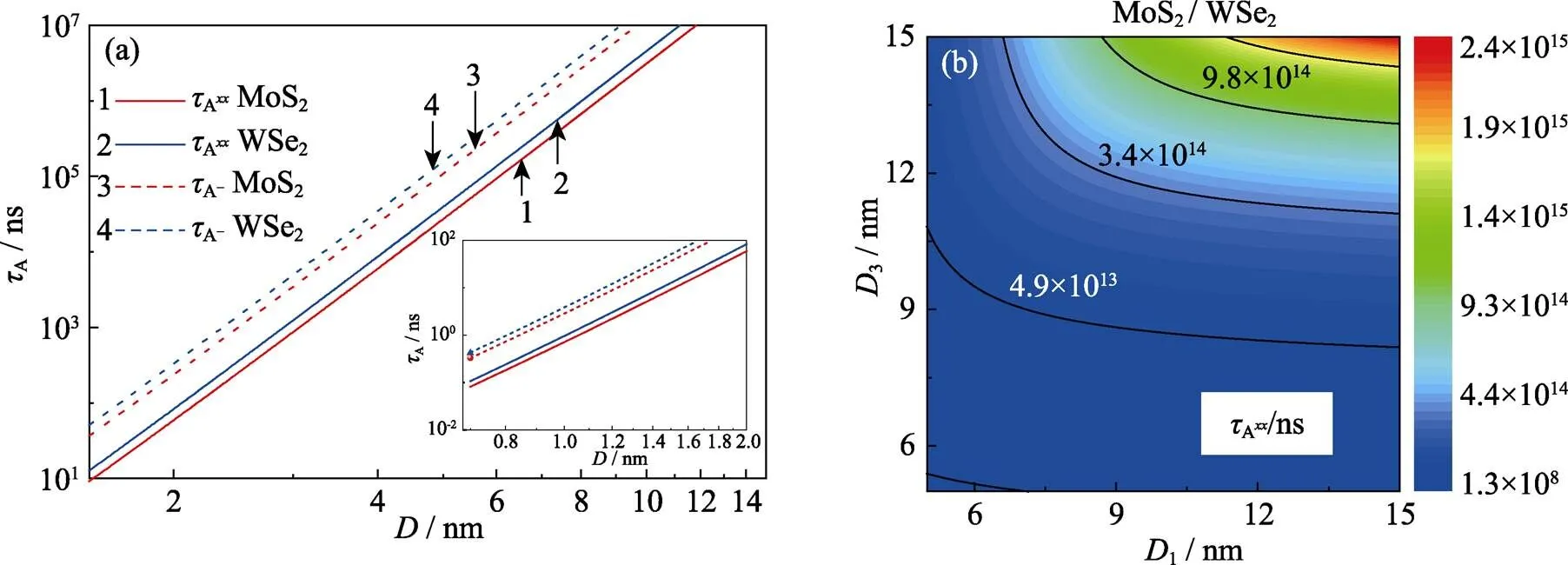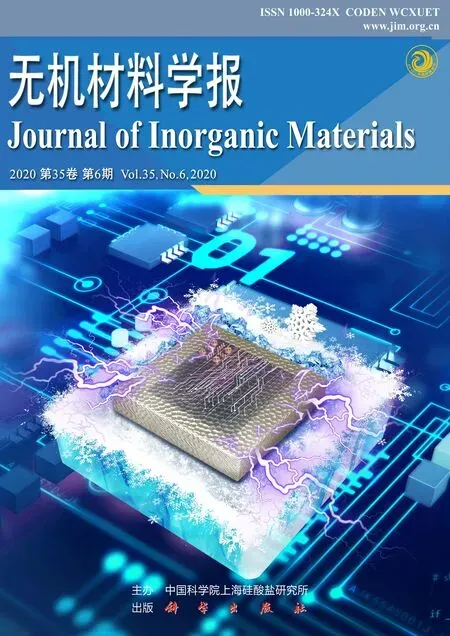尺寸效应对MoS2/WSe2范德华异质结构层间与俄歇复合的界面调控
谭仕林, 尹顺达, 欧阳钢
尺寸效应对MoS2/WSe2范德华异质结构层间与俄歇复合的界面调控
谭仕林, 尹顺达, 欧阳钢
(湖南师范大学 物理与电子科学学院, 低维量子结构与调控教育部重点实验室, 长沙 410081)
为探索界面工程对二维材料范德华异质结构中载流子复合率的影响, 本工作基于界面键弛豫理论和费米黄金定则, 建立了范德华异质结俄歇和层间复合率与各结构组元尺寸之间的理论模型。结果表明, MoS2/WSe2异质结的俄歇复合寿命随着组元尺寸的增大而增加, 且异质结的俄歇复合率远小于相应的单组元体系。在MoS2/WSe2双层异质结中引入薄h-BN插层后, 体系的层间复合率和俄歇复合率随h-BN厚度的增加而分别呈现减小和增大的趋势; 在组元处于单层MoS2和WSe2情况下, 当界面插层h-BN厚度达到9.1 nm时, 俄歇复合率将趋于5.3 ns–1。该研究结果为二维过渡金属硫族化合物基异质结光电器件的优化设计提供了一种理论依据。
MoS2; WSe2; 异质结; 插层绝缘体; 层间复合; 俄歇复合
单层MoS2和WSe2是典型的二维过渡金属硫族化合物(Transition metal dichalcogenides, TMDs)材料, 由于具有优异的光吸收和尺寸可调的带隙等性质[1-3], 可组装成具有II型能级排列的MoS2/WSe2双层范德华异质结构。然而, 由于体系中存在较高的层间载流子复合[4-6], 导致光电转换效率较低(0.1%~2%)[4-6], 不能达到在光电/光伏器件中的实际应用要求。目前研究发现[7-12], 在异质结中引入界面插层, 可有效提高器件性能。如在双层异质结中引入半导体插层可提升载流子迁移率; 而引入薄绝缘体插入层, 则可以抑制层间复合并增强光电转换能力等。
俄歇复合(Auger recombination, AR)是一种以声子形式释放多余能量且与载流子浓度、尺寸和形貌有关的非辐射复合过程, 此外双激子AR是一个三体过程, 可由正俄歇复合和负俄歇复合来描述[13-15]。近年来, 俄歇复合的研究体系主要是单组元体系材料[16-17]和双层异质结构[18-22], 而双层范德华异质结的界面调控研究集中于光谱特性及光电转换方面(包括层间复合)[8,10-12]。在纳米体系中, 由于动量和能量守恒带来的运动约束及电子与空穴之间库仑相互作用的增强效应, 俄歇复合过程会随尺寸的减小而增强, 进而影响纳米器件的光电性能[15,23]。一方面, 二维体系的双激子俄歇复合寿命与厚度或横截面积有关, 而与体积基本无关[16]。另一方面, 由于尺度效应及能带偏移导致光生载流子的有效分离, 具有II型能级排列的双层范德华异质结的双激子俄歇复合寿命将随厚度的增加而变大[18]。此外, 在双层异质结中引入界面合金层, 可延长双激子寿命[19]。将高透光率的插层绝缘体h-BN引入MoS2/WSe2范德华异质结中, 则可抑制载流子的分离和层间复合, 其抑制作用随着h-BN厚度的增大而明显增强[8,10]。另外, 单组元体系材料的载流子迁移率可在三层膜体系中得以保持[24]。这些结果表明异质结的材料尺寸、能级排列类型和界面性质会显著影响体系的层间和俄歇复合。
此外, 载流子复合也是影响范德华异质结器件光电性质的重要因素之一。如前所述, 高载流子复合令MoS2/WSe2的光电性能无法明显提升, 导致其不能实际应用于光伏/光电器件。因此, 有效地调制异质结的层间和俄歇复合以提升光电性能是目前迫切需要解决的问题之一。虽然在实验上双层范德华异质结体系的俄歇和层间复合已取得很大进展[11,12,18-22], 但仍缺乏基于TMDs的半导体–半导体双层范德华异质结的界面调控及其层间和俄歇复合率的相应理论研究。此外, 诸如范德华异质结的非辐射复合物理机制, 组元尺寸与层间和俄歇复合之间的理论关系等一些基本问题还有待阐明和探索。
为此, 为了探索异质结体系的复合机制, 本研究基于界面键驰豫理论[25-28]和费米黄金定则[29], 从原子层次研究了TMDs与插层绝缘体的尺寸对TMDs/TMDs异质结层间和俄歇复合的影响, 得到了尺寸依赖的带隙漂移、俄歇复合率(寿命)和层间复合率的关系, 为TMDs基范德华异质结的优化设计提供了一种理论依据。
1 理论方法
1.1 异质结模型
由于MoS2、WSe2的强光吸收和h-BN的高透光率等性质, 以及h-BN不影响MoS2/h-BN/WSe2中TMDs的层内激子结合能[9], 使得该异质结构在光电器件中具有广阔的应用前景。本工作首先采用Atomistix Toolkit (ATK)建立了垂直堆垛的MoS2/WSe2和MoS2/h-BN/WSe2范德华异质结模型, 如图1所示, 其中,1、2和3分别为MoS2、h-BN和WSe2的厚度。
1.2 理论与方法
1.2.1 键弛豫理论


图1 (a) MoS2/WSe2和(b) MoS2/h-BN/WSe2两种不同范德华异质结构示意图



1.2.2 费米黄金定则








2 结果与讨论

2.1 带隙漂移
各材料带隙的尺寸效应如图2所示, MoS2、WSe2和h-BN的带隙宽度随尺寸的增大而减小, 并迅速趋近于块体值, 且其相应带隙在小尺寸处变化明显, 表明表面原子的影响随厚度的减小而增大。根据键驰豫机理, 表/界面原子的配位缺陷随体系尺寸的减小而增大, 导致原子键收缩, 体系趋近于能量最低的自平衡状态[4], 影响能带的漂移。近年来, 相关的实验研究[2]和第一性原理计算[44]也表明, 带隙随尺寸的减小而增大。单层MoS2(WSe2)的带隙为1.88 eV (1.68 eV), 而相应块体则为1.29 eV (1.20 eV)[2,4], 我们的结果与实验测量和第一性原理计算的结果一致。图2中的插图为三单层MoS2/h-BN/WSe2异质结的能级排列图。显然, h-BN与MoS2之间有较大的电子势垒, 可以有效地抑制层间复合, 从而提升光电转换效率[11-12]。此外, 在保持TMDs厚度不变的情况下, h-BN/TMDs异质界面处的导带偏移与价带偏移都会随着h-BN厚度的增大而减小, 这是纳米体系导带底能量的减小、价带顶能量的增大[39], 以及特殊的能级排列类型所导致。

图2 厚度依赖的MoS2、WSe2和h-BN的带隙
2.2 俄歇复合与层间复合


图3 不同体系的厚度依赖的负俄歇复合寿命()和双激子俄歇复合寿命()



图4 厚度依赖的异质结层间(R)和双激子俄歇复合率()
因此, 在低维纳米结构中, 增大光活性材料TMDs的尺寸和构成异质结是抑制俄歇复合过程的有效方法。此外, 插层绝缘体有益于提升器件性能; 然而插层绝缘体削弱了光生载流子的分离, 并且增强了异质结中的量子限域效应, 导致俄歇复合率增强。值得注意的是, 虽然在计算中假设低维纳米体系具有一个理想的能带结构, 并忽略了异质结界面效应的影响, 但本工作的结果变化趋势与实验测量的变化趋势非常吻合。
3 结论

[1] LI M Y, CHEN C H, SHI Y,Heterostructures based on two-dimensional layered materials and their potential applications.,2016, 19(6): 322–335.
[2] MAK K F, LEE C, HONE J,Atomically thin MoS2: a new direct-gap semiconductor., 2010, 105(13): 136805.
[3] XIAO M, SUN R Z, LI Y F,Transfer printing of VO2thin films using MoS2/SiO2van der Waals heterojunctions., 2019, 34(11): 1161–1166.
[4] ZHAO Y, YU W, OUYANG G. Size-tunable band alignment and optoelectronic properties of transition metal dichalcogenide van der Waals heterostructures., 2017, 51(1): 015111.
[5] CAO G, SHANG A, ZHANG C,Optoelectronic investigation of monolayer MoS2/WSe2vertical heterojunction photoconversion devices., 2016, 30: 260–266.
[6] FURCHI M M, ZECHMEISTER A A, HOELLER F,. Photovoltaics in van der Waals heterostructures., 2016, 23(1): 106–116.
[7] CHEN Q, LI Q, YANG Y,Effects of AlGaN interlayer on scattering mechanisms in InAlN/AlGaN/GaN heterostructures., 2019, 68(1): 017301.
[8] FANG H, BATTAGLIA C, CARRARO C,. Strong interlayer coupling in van der Waals heterostructures built from single-layer chalcogenides., 2014, 111(17): 6198–6202.
[9] LATINI S, WINTHER K T, OLSEN T,. Interlayer excitons and band alignment in MoS2/h-BN/WSe2van der Waals heterostructures., 2017, 17(2): 938–945.
[10] KIM J Y, KIM S G, YOUN J W,Energy and charge transfer effects in two-dimensional van der Waals hybrid nanostructures on periodic gold nanopost array., 2018, 112(19): 193101.
[11] YANG L, YU X, XU M,. Interface engineering for efficient and stable chemical-doping-free graphene-on-silicon solar cells by introducing a graphene oxide interlayer., 2014, 2(40): 16877–16883.
[12] [12] MENG J H, LIU X, ZHANG X W,Interface engineering for highly efficient graphene-on-silicon Schottky junction solar cells by introducing a hexagonal boron nitride interlayer., 2016, 28: 44–50.
[13] SUN W F, LI M C, ZHAO L C. First-principles investigation of carrier Auger lifetime and impact ionization rate in narrow-gap superlattices., 2010, 59(8): 5661–5666.
[14] HE Y, OUYANG G. Geometry-dependent Auger recombination process in semiconductor nanostructures., 2017, 121(42): 23811–23816.
[15] 贺言. 半导体纳米结构的表/界面以及光电性质的调控研究. 长沙: 湖南师范大学博士学位论文, 2017.
[16] LI Q, LIAN T. Area- and thickness-dependent biexciton Auger recombination in colloidal CdSe nanoplatelets: breaking the “universal volume scaling law”., 2017, 17(5): 3152–3158.
[17] LIU S D, CHENG M T, ZHOU H J,. The effect of biexciton, wetting layer leakage and Auger capture on Rabi oscillation damping in quantum dots., 2006, 55(5): 2122–2127.
[18] DENNIS A M, MANGUM B D, PIRYATINSKI A,Suppressed blinking and Auger recombination in near-infrared type-II InP/CdS nanocrystal quantum dots., 2012, 12(11): 5545–5551.
[19] PARK Y S, BAE W K, PADILHA L A,Effect of the core/shell interface on Auger recombination evaluated by single-quantum-dot spectroscopy., 2014, 14(2): 396–402.
[20] JAIN A, VOZNYY O, HOOGLAND S,Atomistic design of CdSe/CdS core-shell quantum dots with suppressed Auger recombination., 2016, 16(10): 6491–6496.
[21] VAXENBURG R, RODINA A, LIFSHITZ E,Biexciton Auger recombination in CdSe/CdS core/shell semiconductor nanocrystals., 2016, 16(4): 2503–2511.
[22] PELTON M, ANDREWS J J, FEDIN I,Nonmonotonic dependence of Auger recombination rate on shell thickness for CdSe/CdS core/shell nanoplatelets., 2017, 17(11): 6900–6906.
[23] BEATTIE A R, LANDSBERG P T. Auger effect in semiconductors., 1959, 249(1256): 16–29.
[24] [24] LU N, GUO H, WANG L,Van der Waals trilayers and superlattices: modification of electronic structures of MoS2by intercalation., 2014, 6(9): 4566–4571.
[25] SUN C Q. Size dependence of nanostructures: impact of bond order deficiency., 2007, 35(1): 1–159.
[26] OUYANG G, WANG C X, YANG G W. Surface energy of nanostructural materials with negative curvature and related size effects., 2009, 109(9): 4221–4247.
[27] ZHANG A, ZHU Z, HE Y,Structure stabilities and transitions in polyhedral metal nanocrystals: an atomic-bond-relaxation approach., 2012, 100(17): 171912.
[28] ZHU Z, ZHANG A, OUYANG G,Edge effect on band gap shift in Si nanowires with polygonal cross-sections., 2011, 98(26): 263112.
[29] CHEPIC D I, EFROS A L, EKIMOV A I,. Auger ionization of semiconductor quantum drops in a glass matrix., 1990, 47(3): 113–127.
[30] [30] OUYANG G, ZHU W G, SUN C Q,Atomistic origin of lattice strain on stiffness of nanoparticles., 2010, 12(7): 1543–1549.
[31] DANOVICH M, ZÓLYOMI V, FAL’KO V I,. Auger recombination of dark excitons in WS2and WSe2monolayers., 2016, 3(3): 035011.
[32] JIN C, KIM J, WU K,On optical dipole moment and radiative recombination lifetime of excitons in WSe2., 2017, 27(19): 1601741.
[33] HUR J H, PARK J, JEON S. A theoretical modeling of photocurrent generation and decay in layered MoS2thin-film transistor photosensors., 2017, 50(6): 065105.
[34] GUO N, WEI J, JIA Y,Fabrication of large area hexagonal boron nitride thin films for bendable capacitors., 2013, 6(8): 602–610.
[35] KIRCHARTZ T, MATTHEIS J, RAU U. Detailed balance theory of excitonic and bulk heterojunction solar cells., 2008, 78(23): 235320.
[36] ZEGRYA G G, ANDREEV A D. Mechanism of suppression of Auger recombination processes in type-II heterostructures., 1995, 67(18): 2681–2683.
[37] HE Y, QUAN J, OUYANG G. The atomistic origin of interface confinement and enhanced conversion efficiency in Si nanowire solar cells., 2016, 18(10): 7001–7006.
[38] ZHANG C, FU L, ZHAO S,Controllable Co-segregation synthesis of wafe-scale hexagonal boron nitride thin films.,2014, 26(11): 1776–1781.
[39] KANG J, TONGAY S, ZHOU J,Band offsets and heterostructures of two-dimensional semiconductors., 2013, 102(1): 012111.
[40] WANG J, MA F, LIANG W,Optical, photonic and optoelectronic properties of graphene, h-BN and their hybrid materials., 2017, 6(5): 943–976.
[41] VU Q A, LEE J H, NGUYEN V L,Tuning carrier tunneling in van der Waals heterostructures for ultrahigh detectivity., 2016, 17(1): 453–459.
[42] DAS S, PRAKASH A, SALAZAR R,Towards low-power electronics: tunneling phenomena in transition metal dichalcogenides., 2014, 8(2): 1681–1689.
[43] CHOI M S, LEE G H, YU Y J,Controlled charge trapping by molybdenum disulphide and graphene in ultrathin heterostructured memory devices., 2013, 4(1): 1624.
[44] YUN W S, HAN S W, HONG S C,. Thickness and strain effects on electronic structures of transition metal dichalcogenides: 2H-MX2semiconductors (M=Mo, W; X=S, Se, Te)., 2012, 85(3): 033305.
[45] GARCÍA-SANTAMARÍA F, BROVELLI S, VISWANATHA R,Breakdown of volume scaling in Auger recombination in CdSe/CdS heteronanocrystals: the role of the core-shell interface., 2011, 11(2): 687–693.
[46] COHN A W, RINEHART J D, SCHIMPF A M,Size dependence of negative trion Auger recombination in photodoped CdSe nanocrystals., 2013, 14(1): 353–358.
[47] HE Y, HU S, HAN T,Suppression of the Auger recombination process in CdSe/CdS core/shell nanocrystals., 2019, 4(5): 9198–9203.
Size Effect on the Interface Modulation of Interlayer and Auger Recombination Rates in MoS2/WSe2van der Waals Heterostructures
TAN Shilin, YIN Shunda, OUYANG Gang
(Key Laboratory of Low-Dimensional Quantum Structures and Quantum Control of Ministry of Education, Hunan Normal University, Changsha 410081, China)
To explore the interface engineering on the carrier recombination in two-dimensional (2D) van der Waals (vdW) heterostructures, we developed a theoretical model to address the size-dependent interlayer and Auger recombination rates in MoS2/WSe2in terms of interface bond relaxation method and Fermi's golden rule. It is found that the Auger recombination lifetime in MoS2/WSe2increases with increasing thickness due to the weakening of Coulomb interaction between holes and electrons, as well as the Auger recombination rate is much smaller than that of MoS2and WSe2units. However, when the thin h-BN layer is introduced into the MoS2/WSe2, the interlayer and Auger recombination rates show opposite trends as the h-BN thickness increases. When the thickness of h-BN reaches 9.1 nm under the condition of 1L MoS2/h-BN/1L WSe2, the Auger recombination rate approaches 5.3 ns–1. These results indicate that the relevant recombination processes can be tuned by interface and dimension. Therefore, our results provide a useful guidance for the optimal design of 2D transition metal dichalcogenides-based optoelectronic nanodevices.
MoS2; WSe2; heterostructure; intercalated insulator; interlayer recombination; Auger recombination
O484
A
1000-324X(2020)06-0682-07
10.15541/jim20190386
2019-07-22;
2019-08-19
国家自然科学基金(11574080, 91833302)National Natural Science Foundation of China (11574080, 91833302)
谭仕林(1994–), 男, 硕士研究生. E-mail: tanshilin_hnu@126.com
TAN Shilin (1994–), male, Master candidate. E-mail: tanshilin_hnu@126.com
欧阳钢, 教授. E-mail: gangouy@hunnu.edu.cn
OUYANG Gang, professor. E-mail: gangouy@hunnu.edu.cn

